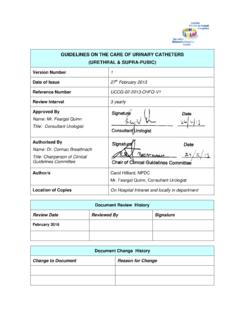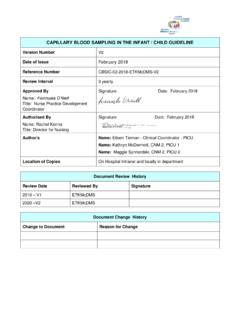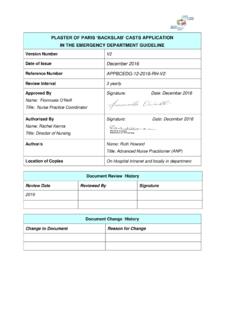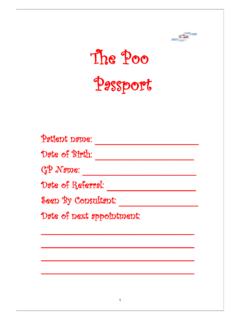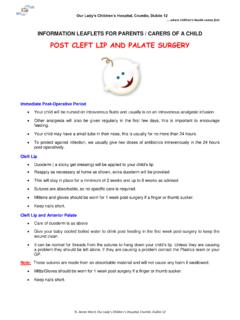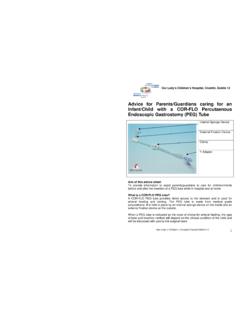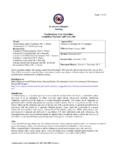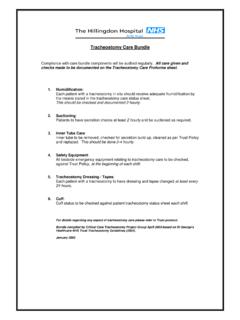Transcription of Guidelines on Nasopharyngeal/ oropharyngeal …
1 Nurse Practice Committee December 2011 1 Nursing Practice Committee Guidelines on nasopharyngeal / oropharyngeal suctioning Author: Paula McGrath CNM 2 St. Theresa s Ward Issue date: December 2011 Marie Lavelle CNF St. Theresa s Ward Review Date: December 2013 Introduction: Airway suctioning is a common practice in the treatment of children with a variety of conditions. Sick children/infants sometimes cannot remove secretions effectively; therefore, these secretions may be removed by suction. Appropriately trained nursing/medical staff or parents/carers should perform suctioning . It is often incorporated into a chest physiotherapy regime. Suction should be considered if a child s breathing is compromised by excessive secretions which can be assessed visually or by auscultation of the child s chest using a stethoscope.
2 (Trigg and Mohammad 2006) The aim of airway suctioning is to clear secretions, thereby maintaining a patent airway and promoting adequate ventilation. Removal of these secretions also minimises the risk of atelectasis (Prasad 1995, AARC Clinical Guideline 2004)) Definition: suctioning is the aspiration and or removal of secretions from the airway via the nasal passage and pharynx without a tracheal tube or tracheostomy (AARC Clinical Guideline 2004). The principles of suctioning are the same whether it is via the child s pharynx or an artificial airway ( tracheal tube or tracheostomy) Routes for suctioning Oral To remove secretions from the mouth and performed using a yankeur suction catheter. oropharyngeal Extends from the lips to the pharynx. Can be performed for children who are breathing spontaneously, but are unable to maintain an open airway.
3 oropharyngeal suctioning requires the insertion of a suction catheter through the mouth to the pharynx. nasopharyngeal Extends from the tip of the nose to the pharynx. The suction catheter is inserted through the nostrils in to the pharynx. Airway adjuncts (guedal) can be used if the child is unable to tolerate suction without them or is in an unconscious state. (Moore 2003, APLS 2005) Indications: Suction is indicated for visible or audible airway secretions, signs of airway obstruction or signs of oxygen deficit that persist in spite of the child s best cough effort. Where possible suctioning should be ideally performed prior to child/infants feed and should be avoided for at least 1 hour after a feed to reduce the risk of vomiting.
4 The need for suctioning may not always be obvious, and the child should be continually assessed to ascertain if suctioning is appropriate. (ARCC 2004, Moore 2003, Ireton 2007, Knox 2011) Other indications: Patient feels/ indicates the presence of secretions in his / her airway Deteriorating arterial blood gas values Altered chest movements Restlessness Decreased oxygen saturation levels Diminished air entry Change of colour Tachypnoea For assessment of airway patency, sputum sample collection and cough reflex stimulation (Moore 2003) Nurse Practice Committee December 2011 2 Caution Suspected epiglottitis Occluded nasal passages Nasal Bleeding Acute head, facial, or neck injury( nasopharyngeal suctioning not advisable with basal skull fractures Coagulopathy or bleeding disorder Laryngospasm Irritable airway Tracheal surgery Gastric surgery with high anastomosis (ARCC 2004) Complications.)
5 suctioning is not a benign procedure and adverse physiological effects directly attributed to oral or nasopharyngeal suctioning are well documented : Hypoxia Atelectasis Cardiovascular changes Intra cranial pressure alterations Pneumothorax Bacterial infection Discomfort/pain Hypo/hypertension Overstimulation of secretions Laryngospasm Sepsis Gagging/vomiting Nosocomial infection Knox 2011, Fitzgerald et al 2008) Equipment: Wall suction/Suction machine with manometer and connector tubing Gloves Sterile suction catheter (a selection of appropriate sizes) Sterile normal saline or water & gallipot Oxygen supply Alcohol hand rub Disposable plastic apron Emergency Equipment Appropriate facial protection for nurse Nurse Practice Committee December 2011 3 Procedure: All routine oral and nasopharyngeal suction should be treated as aseptic non touch technique ANTT level 3.
6 suctioning should be performed as the patients clinical condition dictates (, Moore 2003, OLCHC 2007) The following procedure for oral and nasopharyngeal suction should be followed and repeated until excess saliva/mucus has been removed: PROCEDURE RATIONALE & REFERENCE Perform a comprehensive respiratory assessment and document on the Respiratory assessment chart, OLCHC 2009. Explain procedure to child /family Assemble equipment within easy reach: ensuring suction apparatus is in correct working order and set to appropriate pressure Neonate 60-80 mmhg Child 80-100 mmhg Older Child/ Adult 100-120 mmhg Wash hands and apply alcohol gel. Put on disposable apron and facial equipment as appropriate. Put on gloves. Use ANTT level 3 Place in comfortable secure position. Ask for assistance if needed .Encourage parental involvement if appropriate. Attach the appropriate size sterile suction catheter to tubing using a non-touch technique.
7 Suction catheter diameter must fit comfortably in infants/childs nose,approx size 7Fr in infant Remove outer packaging from the catheter, ensuring that the end of the tube to be passed into the oral/nasal cavity is not handled For nasopharyngeal suctioning measure from tip of the nose to tragus of the ear and insert approx 2cm further. For oropharyngeal suctioning measure from centre of incisors to angle of the jaw and insert approx 2 cm further (APLS Guidelines 2011). This may produce a cough If a child is receiving oxygen therapy, care must be taken to ensure that the supply is not interrupted. If pooled oral secretions present suction mouth first with yankeur suction. Attach the yankeur suction to the suction tubing. Turn on suction machine. Introduce the suction to the oral cavity without applying suction. Apply suction on withdrawal working from the back of the mouth forwards.
8 Rinse tube thoroughly with water and repeat if necessary. With your thumb off the suction control, insert the catheter through the nares or mouth using a slight upwards and backwards slant. Have the patient breathe slowly and deeply (if willing) as the catheter is advanced To assess the need for suctioning . (Day et al 2002) To inform the child and family of the procedure and to reduce stress (Dougherty and Lister 2008)Trauma may occur if infant/child struggles (Knox 2011) To reduce risk of complications. Excessive negative pressure damages nasopharyngeal and tracheal mucosa and can induce greater hypoxia. Too low suction pressure will be ineffective (Hazinski 1992,Moore 2003, Mohammad 2010,Simpson 2009) To reduce the risks of introducing micro organisms as this may be harmful to the child. Gloves and apron will protect the health care worker and reduce the risks to the child (OLCHC 2008) It may be appropriate to use two members of staff.
9 To maintain sterility of the suction catheter To enable gas flow between the suction catheter and the tracheal wall thus minimising the risks of hypoxia and reducing the likelihood of atelectasis developing (Glass and Grap 1995) To maintain sterility of the suction catheter To ensure safe practice, prevent trauma and provide effective suction (Simpson 2009) To minimise the potential effects of hypoxia To maintain a patent airway YANKEUR ONLY FOR ORAL suctioning NOT nasopharyngeal oropharyngeal suctioning less traumatic in the older child if co-operative. If uncooperative nasopharyngeal suctioning may be used Inserting the catheter without suction minimises the risk of mucosal damage and hypoxia. Nurse Practice Committee December 2011 4 Advance the catheter as far as possible to the measured length. Suction catheter should only be passed as far as the pharynx to stimulate a cough Monitor catheter placement whilst observing patient respiratory status.
10 Observe for bleeding in the oral cavity Apply suction (maximum 5-7 secs) as the catheter is gently withdrawn while moving it backwards between the thumb and index finger. Withdraw the catheter gently without rotating the catheter. Observe secretions for signs of infection, obtain sample for microbiology where appropriate. Rinse the catheter and connector tubing by placing in gallipot of water and applying suction. Water for irrigation should be changed 4 hourly The same suction catheter can be inserted a second time as long as there are no secretions visible on the outside. Never suction from nose to mouth Pull disposable gloves over sterile catheter and discard as clinical waste. Encourage patient to cough. Limit procedure time of maximum 2-3 minutes (patient specific) Reapply oxygen as patient condition dictates. Reassess the patient s respiratory status.
